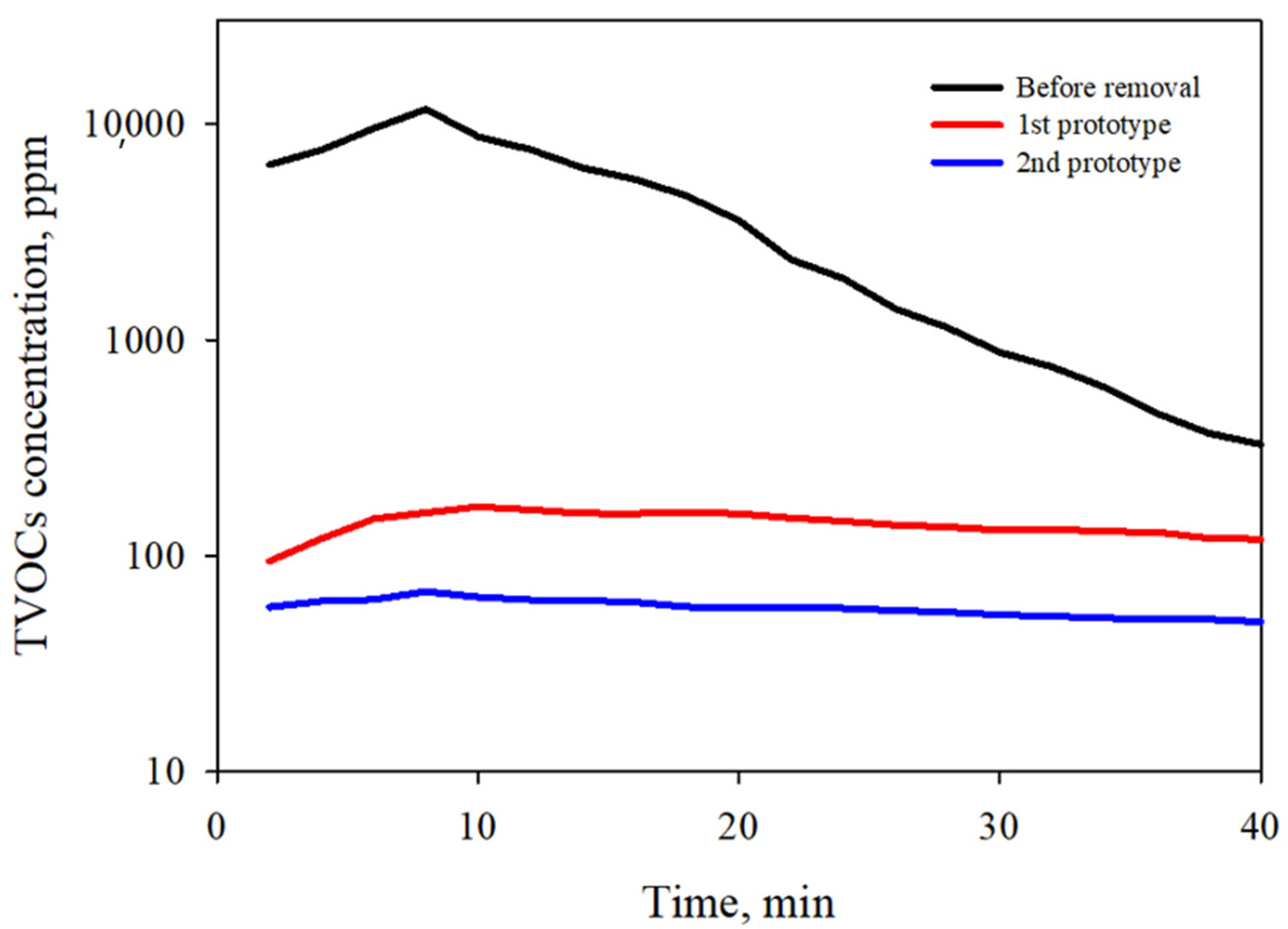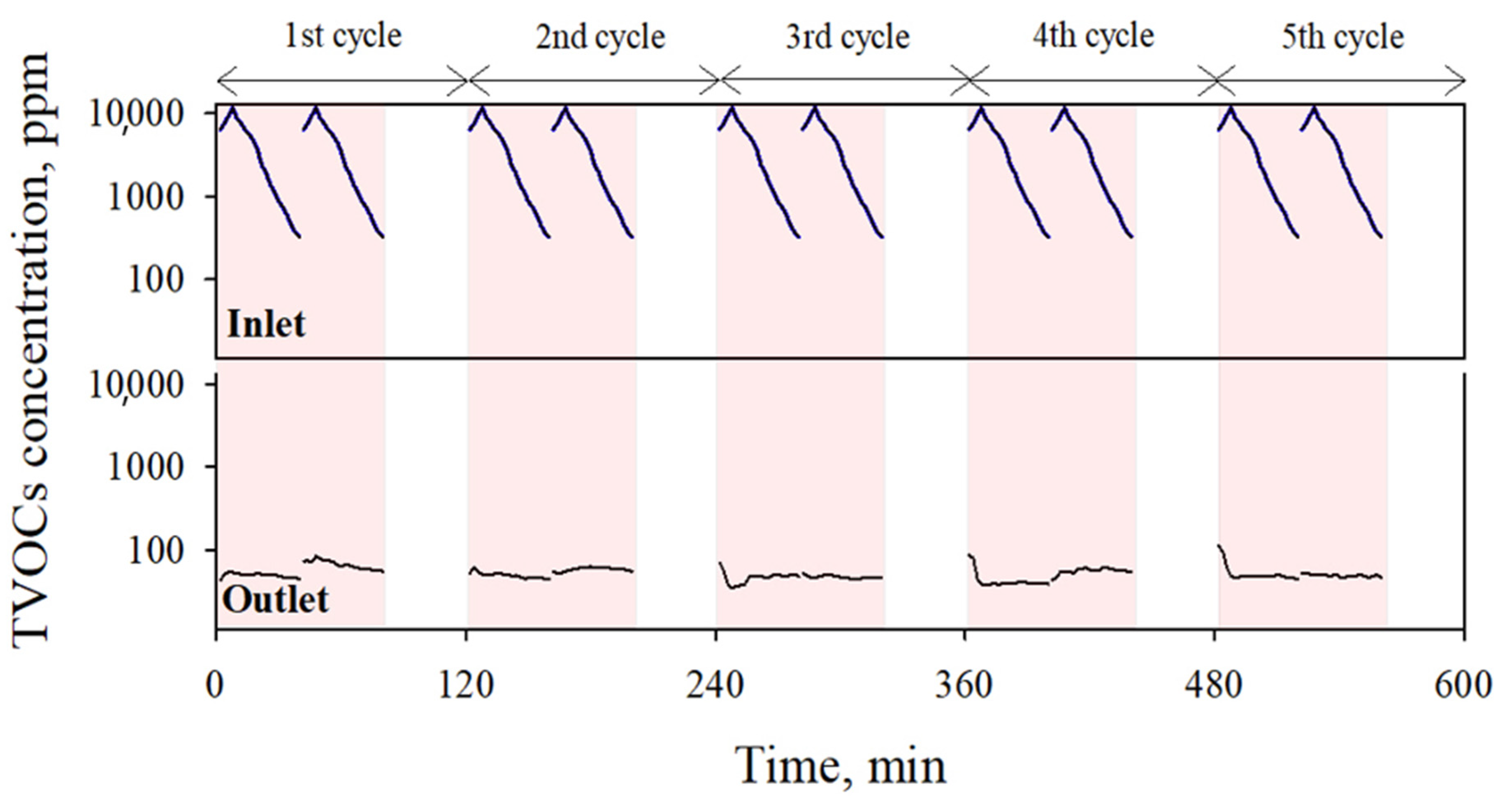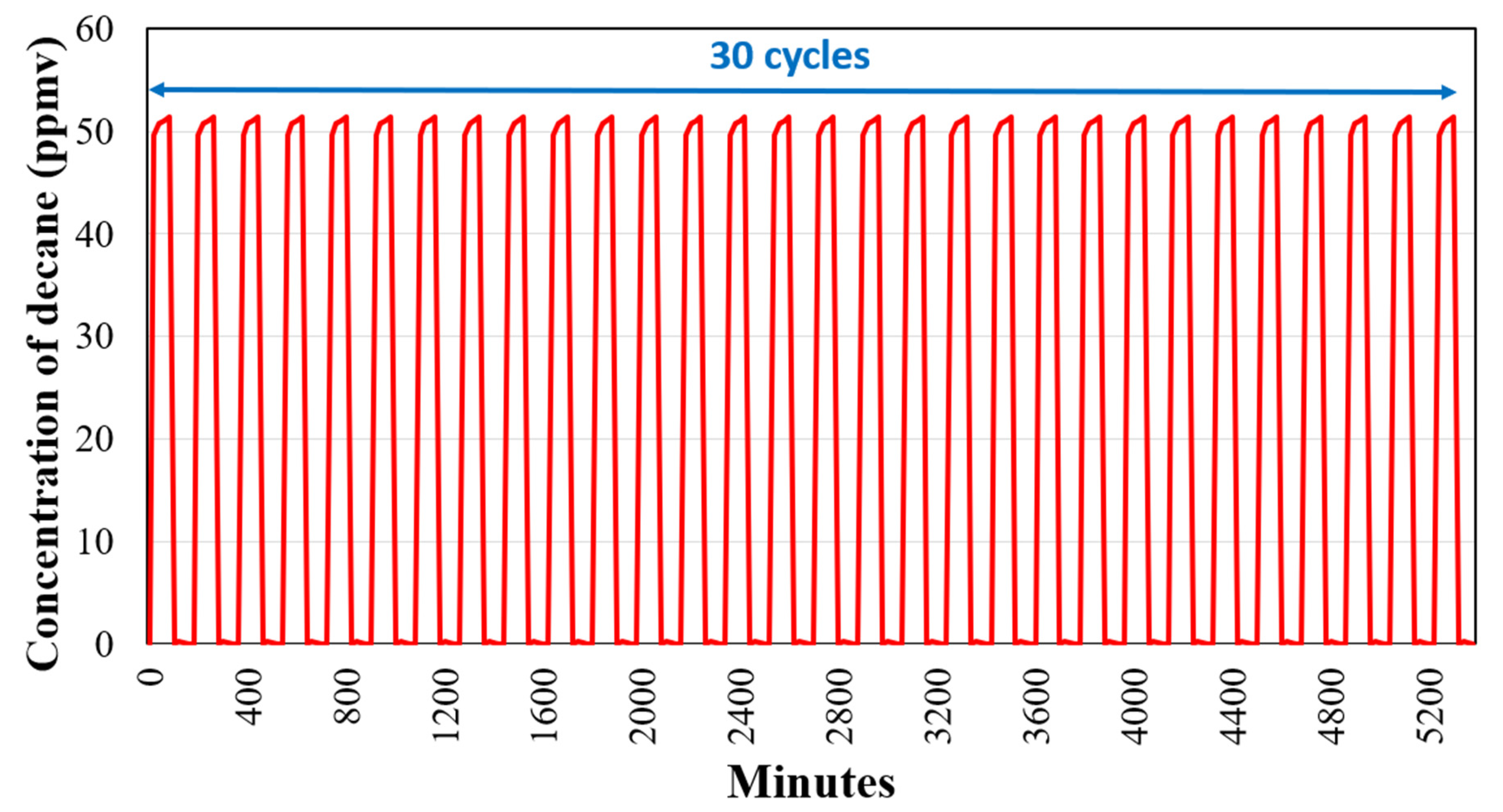Reduction of Volatile Organic Compounds (VOCs) Emissions from Laundry Dry-Cleaning by an Integrated Treatment Process of Condensation and Adsorption
Abstract
:1. Introduction
2. Materials and Methods
2.1. Dry-Cleaning Process
2.2. VOC-Reduction Process
2.3. VOCs Sampling and Analysis
2.4. Process Simulation
2.5. Effect of the VOC-Reduction Process on the Atmosphere
3. Results and Discussion
3.1. Determination of VOC-Reduction Process Parameters
3.2. VOC Reduction
3.3. Long-Term Repetitive Operation of the VOC-Reduction Process
3.4. Process Simulation
3.5. Reduction in POCP-Weighted and SOAP-Weighted Emission
4. Conclusions
Supplementary Materials
Author Contributions
Funding
Institutional Review Board Statement
Informed Consent Statement
Data Availability Statement
Acknowledgments
Conflicts of Interest
References
- Goldstein, A.H.; Galbally, I.E. Known and unexplored organic constituents in the earth’s atmosphere. Environ. Sci. Technol. 2007, 41, 1514–1521. [Google Scholar] [CrossRef] [Green Version]
- Sahu, L.K.; Saxena, P. High time and mass resolved PTR-TOF-MS measurements of VOCs at an urban site of India during winter: Role of anthropogenic, biomass burning, biogenic and photochemical sources. Atmos. Res. 2015, 164, 84–94. [Google Scholar] [CrossRef]
- Velasco, E.; Lamb, B.; Westberg, H.; Allwine, E.; Sosa, G.; Arriaga-Colina, J.L.; Jobson, B.T.; Alexander, M.L.; Prazeller, P.; Knighton, W.B.; et al. Distribution, magnitudes, reactivities, ratios and diurnal patterns of volatile organic compounds in the Valley of Mexico during the MCMA 2002 & 2003 field campaigns. Atmos. Chem. Phys. 2007, 7, 329–353. [Google Scholar]
- Cetin, E.; Odabasi, M.; Seyfioglu, R. Ambient volatile organic compound (VOC) concentrations around a petrochemical complex and a petroleum refinery. Sci. Total Environ. 2003, 312, 103–112. [Google Scholar] [CrossRef]
- McDonald, B.C.; De Gouw, J.A.; Gilman, J.B.; Jathar, S.H.; Akherati, A.; Cappa, C.D.; Jimenez, J.L.; Lee-Taylor, J.; Hayes, P.L.; McKeen, S.A.; et al. Volatile chemical products emerging as largest petrochemical source of urban organic emissions. Science 2018, 359, 760–764. [Google Scholar] [CrossRef] [Green Version]
- Yuan, B.; Shao, M.; Lu, S.; Wang, B. Source profiles of volatile organic compounds associated with solvent use in Beijing, China. Atmos. Environ. 2010, 44, 1919–1926. [Google Scholar] [CrossRef]
- Liu, H.; Liu, S.; Xue, B.; Lv, Z.; Meng, Z.; Yang, X.; Xue, T.; Yu, Q.; He, K. Ground-level ozone pollution and its health impacts in China. Atmos. Environ. 2018, 173, 223–230. [Google Scholar] [CrossRef]
- Liu, Y.; Shao, M.; Fu, L.; Lu, S.; Zeng, L.; Tang, D. Source profiles of volatile organic compounds (VOCs) measured in China: Part I. Atmos. Environ. 2008, 42, 6247–6260. [Google Scholar] [CrossRef]
- Shin, M.H.; McKone, T.E.; Bennett, D.H. Contribution of low vapor pressure-volatile organic compounds (LVP-VOCs) from consumer products to ozone formation in urban atmospheres. Atmos. Environ. 2015, 108, 98–106. [Google Scholar] [CrossRef]
- Huang, B.; Lei, C.; Wei, C.; Zeng, G. Chlorinated volatile organic compounds (Cl-VOCs) in environment—Sources, potential human health impacts, and current remediation technologies. Environ. Int. 2014, 71, 118–138. [Google Scholar] [CrossRef]
- Shuai, J.; Kim, S.; Ryu, H.; Park, J.; Lee, C.K.; Kim, G.B.; Ultra, V.U.; Yang, W. Health risk assessment of volatile organic compounds exposure near Daegu dyeing industrial complex in South Korea. BMC Public Health 2018, 18, 528. [Google Scholar] [CrossRef] [PubMed] [Green Version]
- United States Environmental Protection Agency. Initial List of Hazardous air Pollutants with Modifications. 1990. Available online: https://www.epa.gov/haps/initial-list-hazardous-air-pollutants-modifications (accessed on 8 July 2021).
- Klepeis, N.E.; Nelson, W.C.; Ott, W.R.; Robinson, J.P.; Tsang, A.M.; Switzer, P.; Behar, J.V.; Hern, S.C.; Engelmann, W.H. The National Human Activity Pattern Survey (NHAPS): A resource for assessing exposure to environmental pollutants. J. Expo. Anal. Environ. Epidemiol. 2001, 11, 231–252. [Google Scholar] [CrossRef] [PubMed] [Green Version]
- Stockwell, C.E.; Coggon, M.M.; Gkatzelis, G.I.; Ortega, J.; McDonald, B.C.; Peischl, J.; Aikin, K.; Gilman, J.B.; Trainer, M.; Warneke, C. Volatile organic compound emissions from solvent- and water-borne coatings—Compositional differences and tracer compound identifications. Atmos. Chem. Phys. 2021, 21, 6005–6022. [Google Scholar] [CrossRef]
- Lee, H.; Kim, K.; Choi, Y.; Kim, D. Emissions of Volatile Organic Compounds (VOCs) from an Open-Circuit Dry Cleaning Machine Using a Petroleum-Based Organic Solvent: Implications for Impacts on Air Quality. Atmosphere 2021, 12, 637. [Google Scholar] [CrossRef]
- Park, O.H.; Lee, K.S.; Min, K.W.; Cho, G.W.; Yoon, K.J.; Jeong, W.S.; Cho, Y.G.; Kim, E.S.; Yang, J.S. Generating characteristics of VOCs in a commercial laundry shop and the effects on the health of workers. J. Korean Soc. Occup. Environ. Hyg. 2016, 26, 159–169. [Google Scholar] [CrossRef] [Green Version]
- Huang, D.; Li, Q.; Wang, X.; Li, G.; Sun, L.; He, B.; Zhang, L.; Zhang, C. Characteristics and Trends of Ambient Ozone and Nitrogen Oxides at Urban, Suburban, and Rural Sites from 2011 to 2017 in Shenzhen, China. Sustainability 2018, 10, 4530. [Google Scholar] [CrossRef]
- Ryu, J.; Park, C.; Jeon, S.W. Mapping and Statistical Analysis of NO2 Concentration for Local Government Air Quality Regulation. Sustainability 2019, 11, 3809. [Google Scholar] [CrossRef] [Green Version]
- Ding, Y. Volatile Organic Compound Liquid Recovery by the Dead End Gas Separation Membrane Process: Theory and Process Simulation. Ind. Eng. Chem. Res. 2019, 58, 5008–5017. [Google Scholar] [CrossRef]
- Rinner, M.; Kind, M.; Schlünder, E.U. Separated solvent recovery from waste gas with cryo-condensation. Sep. Purif. Technol. 2002, 29, 95–104. [Google Scholar] [CrossRef]
- Lillo-Ródenas, M.A.; Cazorla-Amorós, D.; Linares-Solano, A. Behaviour of activated carbons with different pore size distributions and surface oxygen groups for benzene and toluene adsorption at low concentrations. Carbon 2005, 43, 1758–1767. [Google Scholar] [CrossRef]
- Sui, H.; Liu, H.; An, P.; He, L.; Li, X.; Cong, S. Application of silica gel in removing high concentrations toluene vapor by adsorption and desorption process. J. Taiwan Inst. Chem. Eng. 2017, 74, 218–224. [Google Scholar] [CrossRef]
- Li, X.; Ma, J.; Ling, X. Design and dynamic behaviour investigation of a novel VOC recovery system based on a deep condensation process. Cryogenics 2020, 107, 103060. [Google Scholar] [CrossRef]
- Gupta, V.K.; Verma, N. Removal of volatile organic compounds by cryogenic condensation followed by adsorption. Chem. Eng. Sci. 2002, 57, 2679–2696. [Google Scholar] [CrossRef]
- Vellingiri, K.; Kumar, P.; Deep, A.; Kim, K.H. Metal-organic frameworks for the adsorption of gaseous toluene under ambient temperature and pressure. Chem. Eng. J. 2017, 307, 1116–1126. [Google Scholar] [CrossRef]
- Lee, H.J.; Song, M.G.; Kim, D.K. Estimation of emissions and emission factor of volatile organic compounds from small-scale dry cleaning operations using organic solvents. J. Korean Soc. Atmos. Environ. 2019, 35, 413–422. [Google Scholar] [CrossRef]
- Buker, M.S.; Mempouo, B.; Riffat, S.B. Experimental investigation of a building integrated photovoltaic/thermal roof collector combined with a liquid desiccant enhanced indirect evaporative cooling system. Energy Convers. Manag. 2015, 101, 239–254. [Google Scholar] [CrossRef]
- Kim, D.; Park, J.M.; Lee, S.S. Evaluation of Non-Carbon Adsorbents for the Removal of Volatile Organic Compounds Emitted from Laundry Facilities. J. Korean Soc. Atmos. Environ. 2021, 37, 91–101. [Google Scholar] [CrossRef]
- Yang, P.; Song, M.; Kim, D.; Jung, S.P.; Hwang, Y. Synthesis conditions of porous clay heterostructure (PCH) optimized for volatile organic compounds (VOC) adsorption. Korean J. Chem. Eng. 2019, 36, 1806–1813. [Google Scholar] [CrossRef]
- Vo, T.K.; Quang, D.T.; Song, M.; Kim, D.; Kim, J. Rapid defect engineering of UiO-67 (Zr) via microwave-assisted continuous-flow synthesis: Effects of modulator species and concentration on the toluene adsorption. Microporous Mesoporous Mater. 2020, 306, 110405. [Google Scholar] [CrossRef]
- Mertz, K.A.; Gobin, F.; Hand, D.W.; Hokanson, D.R.; Crittenden, J.C. Adsorption Design Software for Windows; Elf Aquitaine, Inc.: Houghton, MI, USA, 1994. [Google Scholar]
- Kim, D.; Sorial, G.A. Comparative study of gas phase adsorption of volatile organic compounds on two types of activated carbon. Abstr. Pap. Am. Chem. Soc. 2004, 227, U811. [Google Scholar]
- Wu, W.; Zhao, B.; Wang, S.; Hao, J. Ozone and secondary organic aerosol formation potential from anthropogenic volatile organic compounds emissions in China. J. Environ. Sci. 2017, 53, 224–237. [Google Scholar] [CrossRef] [PubMed]
- Derwent, R.G.; Jenkin, M.E.; Utembe, S.R.; Shallcross, D.E.; Murrells, T.P.; Passant, N.R. Secondary organic aerosol formation from a large number of reactive man-made organic compounds. Sci. Total Environ. 2010, 408, 3374–3381. [Google Scholar] [CrossRef] [PubMed]
- Lin, Y.C.; Chang, F.T.; Bai, H.; Pei, B.S. Control of VOCs emissions by condenser pre-treatment in a semiconductor fab. J. Hazard. Mater. 2005, 120, 9–14. [Google Scholar] [CrossRef] [PubMed]






| Open-Circuit Flow Process (1st Prototype) | Closed-Loop Flow Process (2nd Prototype) | |
|---|---|---|
| Total system volume | 1.26 m3 (850 × 1100 × 1350 mm) | 0.66 m3 (500 × 800 × 1650 mm) |
| Condenser | ||
| Maximum power | 3 kW | 1.5 kW |
| Number of columns | 1 | 3 |
| Condensation temperature | 2 °C (condensation/adsorption) −8 °C (desorption/condensation) | −10 °C (condensation/adsorption) −10 °C (desorption/condensation) |
| Adsorber | ||
| Packed volume | 0.008 m3 | 0.008 m3 |
| Adsorbent (packing volume composition) | Activated alumina a (95.8) | Activated alumina a (88.9) |
| PCH b (2.3) | MOF c (11.1) | |
| MOF c (1.9) | ||
| Space velocity | 8694 h−1 | 10,928 h−1 |
| Heat exchanger | ||
| Maximum power | 2 kW | 1 kW |
Publisher’s Note: MDPI stays neutral with regard to jurisdictional claims in published maps and institutional affiliations. |
© 2021 by the authors. Licensee MDPI, Basel, Switzerland. This article is an open access article distributed under the terms and conditions of the Creative Commons Attribution (CC BY) license (https://creativecommons.org/licenses/by/4.0/).
Share and Cite
Song, M.; Kim, K.; Cho, C.; Kim, D. Reduction of Volatile Organic Compounds (VOCs) Emissions from Laundry Dry-Cleaning by an Integrated Treatment Process of Condensation and Adsorption. Processes 2021, 9, 1658. https://doi.org/10.3390/pr9091658
Song M, Kim K, Cho C, Kim D. Reduction of Volatile Organic Compounds (VOCs) Emissions from Laundry Dry-Cleaning by an Integrated Treatment Process of Condensation and Adsorption. Processes. 2021; 9(9):1658. https://doi.org/10.3390/pr9091658
Chicago/Turabian StyleSong, Mugeun, Kyunghoon Kim, Changmin Cho, and Daekeun Kim. 2021. "Reduction of Volatile Organic Compounds (VOCs) Emissions from Laundry Dry-Cleaning by an Integrated Treatment Process of Condensation and Adsorption" Processes 9, no. 9: 1658. https://doi.org/10.3390/pr9091658
APA StyleSong, M., Kim, K., Cho, C., & Kim, D. (2021). Reduction of Volatile Organic Compounds (VOCs) Emissions from Laundry Dry-Cleaning by an Integrated Treatment Process of Condensation and Adsorption. Processes, 9(9), 1658. https://doi.org/10.3390/pr9091658







